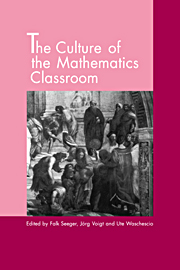14 - About the notion of culture in mathematics education
Published online by Cambridge University Press: 03 May 2010
Summary
It is one of the worst concepts ever formulated.
N. LuhmannCulture has become a household word, if not a catchword, as in “the culture of the (mathematics) classroom.” We run into difficulties as soon as we interpret the term “culture” in more general terms as the constructing of a human-made reality. Reality for whom? For all, for learners, or for members only? Constructing from what or with what? Are there means, prerequisites, or (other) prior realities? Though constructing indicates a process, the obvious aim is the evolving reality, a product. Is it both, process and product? If it is a changing process, and, for that reason, an issue with a history, what is its identity? There is no end to this.
This brings to mind Gregory Bateson's famous metalogues, discussions between father and daughter about problematic themes. The last and richest one, “What is an instinct?” (Bateson 1969), defines instinct as an “explanatory principle” and ascertains that an explanatory principle explains “anything you want it to explain,” and thus it “really explains nothing. It's a sort of conventional agreement between scientists to stop trying to explain things at a certain point” (1969: 12).
This, perhaps, may serve as a promising starting point. Culture, like instinct, context, intelligence, learning, and many other terms in frequent use, serves as an explanatory principle. It would be worthwhile for more than one doctoral dissertation to analyze the many different uses in education, and in mathematics education in particular. An application of Derrida's (1977) method of “deconstruction” would promise helpful insights into many contradictions, inconsistencies, cloudy extensions, and even suppressed meanings and distortions (see Merz and Knorr-Cetina 1997).
- Type
- Chapter
- Information
- The Culture of the Mathematics Classroom , pp. 375 - 390Publisher: Cambridge University PressPrint publication year: 1998
- 8
- Cited by



